The Cathedral of St Domnius is located in the centre of Diocletian’s Palace in the heart of Split and was originally the Mausoleum of the Roman Emperor Diocletian (284-316) who died in Split in 316.
Octagonal in plan, the Mausoleum was constructed of large stone blocks to a height of 24 metres (73.7 ft). The walls were 2.75 metres (9 ft) thick and it was surrounded by 28 granite and marble columns which were brought from Greek and Egyptian temples. The floor was originally nearly seven inches lower than today’s level and was covered in mosaic. Part of this original floor has been glazed over which provides a viewing window over the mosaic. The dome seen today is in its original state, being of brick construction.
In the 7th century Diocletian’s sarcophagus, which stood in the centre of the room, was removed, along with a number of pagan statues, and the building was converted to a Christian Cathedral by Bishop John of Ravenna. It is not known what happened to the sarcophagus but, as Diocletian persecuted the Christians, it is unlikely that it would have received any favourable treatment.
The remains of a number of martyrs who died under Diocletian’s persecutions were brought to the cathedral where they were interned. Their deaths occurred in 303 AD when Diocletian issued a series of edicts rescinding the legal rights of Christians and demanding that they comply with traditional Roman religion. Known as the Diocletianic or Great Persecution, this was the last and most severe persecution of Christians in the Roman Empire.
Originally, the building had only one door, whereas now it has two. The main entrance has a double door carved out of walnut. This dates to 1214 and consist of 28 carved panels with each panel representing an aspect of Christ’s life. These were originally coloured and gold-plated.

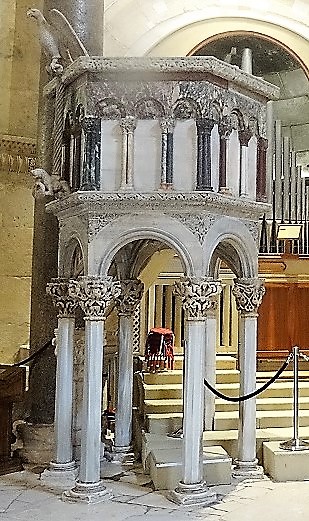
On entry through these doors, located on the left, is a Romanesque pulpit dating from the 13th century. This is made from multi-coloured marble and is supported by six columns, each with its own unique capital, which at one time were gold-plated. The upper part is hexagonal in shape while the lectern is in the shape of a winged eagle, the symbol of St John the Evangelist.
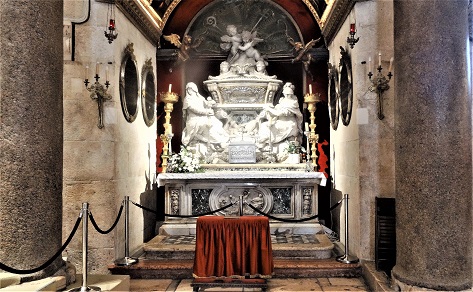
Just to the right of the pulpit in a semi-circular niche is the old altar of St Domnius. St Domnius is the Patron saint of Split who was beheaded in 304 during the persecutions. The altar is Gothic in style, dating from 1427. Upon it lies an effigy of St Domnius.
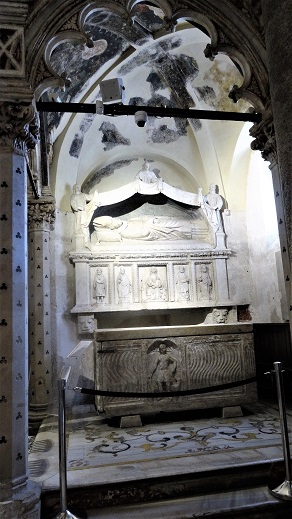
In 1770 a new altar was built for the church. The remains of St Arnir, Splits Archbishop who was martyred in 1180, were placed within the altar making it a rare example of a sarcophagus being used as an altar.
The floor was originally nearly seven inches lower than today’s level and was covered in mosaic. This floor has been recovered but a viewing window over the original mosaic has been left to the front of the altar of St Arnir.
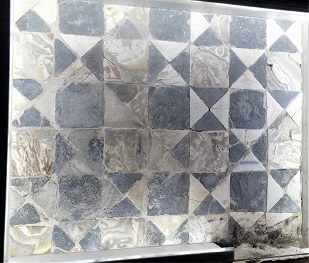
Where the main altar now stands was previously the limit of the room, but the room was extended to enable the construction of the choir, the Bishop’s seat, and clergy. The existing altar is placed where the wall previously stood. This altar is positioned under a beautiful curved ceiling and incorporates two angles.
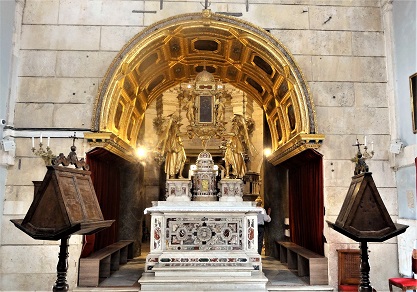
The choir has richly carved stalls from the 13th century. The Bishop’s seat is that of Archbishop Ponzoni (1616-1641) who is buried underneath it. Along the walls are canvases, the largest one having been painted by Pietro Ferrari in 1685, which depicts the life of St Domnius.
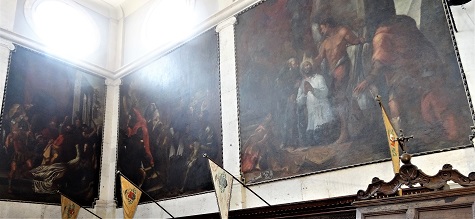
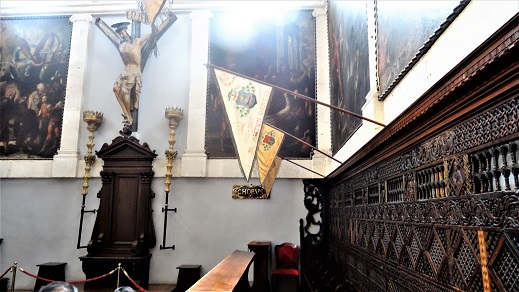
Exiting a door from the side of the choir, stairs lead up to the treasury, which contains a selection of religious artefacts, some dating back to the 7th century.
The peripteral, a porch running around the outside of the cathedral, was originally roofed and, during the Middle Ages, was where Split’s dignitaries were buried.
 Above the main entrance is a small sarcophagus containing the remains of two daughters of King Bela IV (1235 - 1270) of Hungary and Croatia.
Above the main entrance is a small sarcophagus containing the remains of two daughters of King Bela IV (1235 - 1270) of Hungary and Croatia.
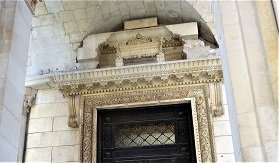
King Bela had to flee Hungary in 1241 following his defeat by the Mongols at the Battle of Mohi during their invasion of Hungary. The king was forced to flee from town to town to avoid his pursuers.
Just outside of the main door, across the peripteral, is the Romanesque-Gothic Campanile, or bell tower.
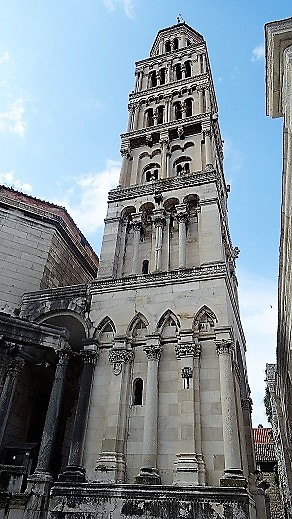 Romanesque-Gothic in style construction on this started in the first half of the 13th century and was to take over 300 years to complete. It was built of stone which eroded over time, requiring its reconstruction during the years 1890 – 1906, although some of the old reliefs were reused. Built to a height of 57 metres (187 ft) visitors are can access the bells and the top of the tower which provides good views over the city of Split.
Romanesque-Gothic in style construction on this started in the first half of the 13th century and was to take over 300 years to complete. It was built of stone which eroded over time, requiring its reconstruction during the years 1890 – 1906, although some of the old reliefs were reused. Built to a height of 57 metres (187 ft) visitors are can access the bells and the top of the tower which provides good views over the city of Split.
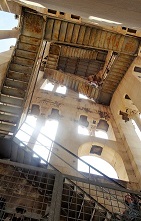
Located underneath the cathedral is the crypt of St Lucy, which has the same circular plan as the church above. St Lucy (St Lucia of Syracuse) is the patron saint of the blind, having had her eyes gouged out before being martyred under the purge of Diocletian.

A short walk from the Cathedral is the Baptistery of St John which was the Temple of Jupiter before it was converted in the 6th century.

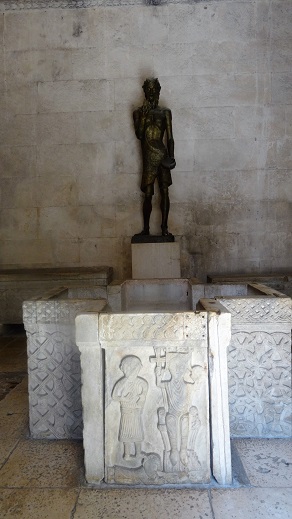
The statue of Jupiter was replaced by a large bronze statue of St. John the Baptist standing on a plinth. In front of the statue is the baptismal font, which today people tend to throw coins into. The font was made in the 13th century from parts of the altar partition which were removed from the cathedral when the choir and Bishop’s seat were added. In the 13th century, the baptismal font was made from parts of the altar partition which were removed from the cathedral.



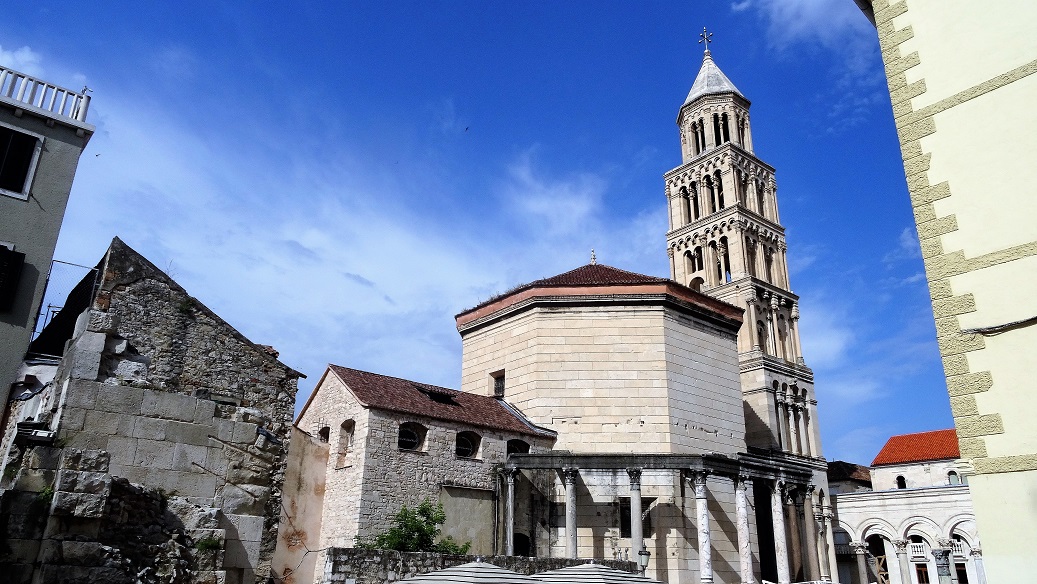








 Above the main entrance is a small sarcophagus containing the remains of two daughters of King Bela IV (1235 - 1270) of Hungary and Croatia.
Above the main entrance is a small sarcophagus containing the remains of two daughters of King Bela IV (1235 - 1270) of Hungary and Croatia. 
 Romanesque-Gothic in style construction on this started in the first half of the 13th century and was to take over 300 years to complete. It was built of stone which eroded over time, requiring its reconstruction during the years 1890 – 1906, although some of the old reliefs were reused. Built to a height of 57 metres (187 ft) visitors are can access the bells and the top of the tower which provides good views over the city of Split.
Romanesque-Gothic in style construction on this started in the first half of the 13th century and was to take over 300 years to complete. It was built of stone which eroded over time, requiring its reconstruction during the years 1890 – 1906, although some of the old reliefs were reused. Built to a height of 57 metres (187 ft) visitors are can access the bells and the top of the tower which provides good views over the city of Split.


